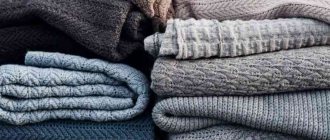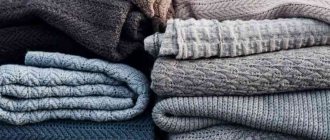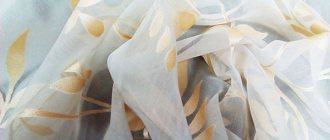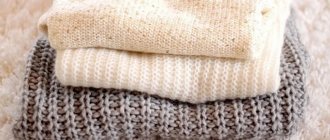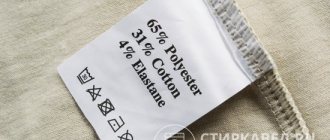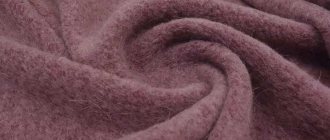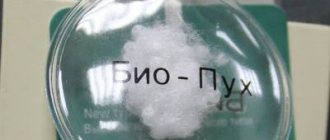Features of wool fabrics
Wool is a natural raw material. In general, it is divided into living and dead. The first is sheared from live sheep, the material is characterized by increased softness, wear and durability. Wool, called dead wool, has much worse characteristics because it is obtained from slaughtered animals in slaughterhouses.
- camel's wool;
- merino (a special breed of fine-wool sheep that is shorn only at the withers);
- cashmere (down from Tibetan goats);
- mohair (fur from Angora goats);
- Angora (fluff obtained from very fluffy Angora rabbits);
- alpaca (a type of wool obtained from Peruvian llamas).
The labels will help you figure out at what temperature to wash wool. The fact is that natural wool is a very fancy material. In particular, when washing it can:
- deform;
- change color;
- sit down;
- lose natural softness.
Decoding symbols for caring for natural wool products.
Often, washing wool, or more precisely, white items, ends with them turning yellow. In addition, pilling often occurs on washed woolen clothes.
There are simple guidelines to follow if you don't want to see a clean but deformed item. For example, many people are interested in whether wool shrinks after washing. Yes, it shrinks - this happens due to the fact that the woolen product is in the water for too long. Experts do not recommend soaking wool so that it spends as little time in water as possible.
Another recommendation worth considering is that if you can avoid washing items made from wool, you should do so. This material does not retain odors well, so instead of washing, you can simply air the item. If there is a dirty spot on it, try to clean it with a brush. Your task is to make woolen products washed less often.
At what temperature should I wash wool? An important tip concerns water temperature. To safely wash wool, the temperature will be sufficient at 30-40 degrees. However, do not change these parameters throughout the entire process. Washing in hot water and then rinsing in cold water is a recipe for deformation of the fabric!
Natural wool can be washed by hand or in a machine. In this case, hand washing is the best option. There is no need to carefully rub the product, twist it or squeeze it hard. The more careful you are with the material, the better the clean item will look.
When choosing a detergent for wool, you should choose special powders that are designed for such fabrics. The right substance will help the product remain soft and avoid pilling. In addition, woolen clothes washed by hand using a specialized product will not deform and will retain their size.
Experienced housewives use soap foam or finely cut soap for hand washing. If you want to wash a mohair or angora sweater, you can do it with shampoo.
When choosing a washing machine, use the “delicate wash” format for wool. This will help avoid the same deformation. As for the products, it is better to use not bulk, but liquid formulations intended for such a fastidious material. Also avoid using conditioner and bleach.
Washing items made from different types of wool
Depending on what kind of wool a particular product is made from, you need to use different washing options. It is worth noting that there is no fundamental difference in cleaning blankets (except for size and labor intensity) from other things. You can also clean a wool jacket and a small scarf in the same way.
Since wool is a living natural material, the structure of its fibers looks like separate scales, which, due to their loose fit to each other, form gaps filled with air. It is this air gap that creates the greenhouse effect, which warms a person.
However, when woolen items are exposed to high temperature or moisture, the scales shrink, displace air and the wool turns into one homogeneous lump. The thing sits down and falls off. To restore the original structure, you need to apply skill and considerable effort. Considering all the difficulties of using woolen items, it is fair to ask the question: is it possible to wash wool, and if not, how to avoid it?
If trouble happens and the clothes become dirty to such an extent that other cleaning methods do not help, then it is important to adhere to the following rules:
- carefully read the information on the label attached to wool clothing. It should contain information about methods for removing contaminants;
- There are very fluffy products, then first you need to lightly comb them. This procedure can slightly comb out surface dirt;
- For any type of washing, the product must first be turned inside out;
- Try to wash it no more than once every six months. This is the optimal frequency. The fact is that woolen items do not get dirty as intensely as those made from other materials. And if you consider that many contaminants can be removed by dry cleaning and airing, then the frequency can even be increased. This is especially true for white things. They may appear yellowish;
- It is recommended to wash by hand. If machine washing is allowed for some woolen items, then the type of work switch should be set to “wool mode”;
- the water should be warm, within 30-35 degrees. At temperatures exceeding 40 degrees, clothing may deteriorate. For example, a wool coat can stretch and lose its elegance;
- Do not change the water temperature during the washing process. For example, use cold water to rinse. A sharp change in water temperature leads to the destruction of wool fibers and holes may appear in clothes;
- no need to use conventional washing powders. A number of special products have been developed for wool;
- woolen items do not need to be soaked;
- wool should not be rubbed. This can lead to fiber breakage and hole formation.
We suggest you familiarize yourself with How to remove odor from a kettle - the secrets of experienced housewives
What products can be used to wash a down jacket?
Winter clothes with natural filling (usually down and feathers of waterfowl) have their own characteristics. Therefore, washing a down jacket with the same detergent that is used for linen and other things usually leads to the following “side effects”:
- White spots, stripes and stains appear on the surface of the fabric. The fact is that ordinary powders and gels contain bleaching components and also form a lot of foam. All this is poorly washed out from the loose fluff and dense “top” fabric. Therefore, if you wash a down jacket with powder, the appearance of “soap” stains is inevitable.
- The fluff falls off and sticks together into clumps. Regular powders and gels contain special substances that destroy fat. Meanwhile, it is the fat component that allows the fluff and feathers in the filler to retain their shape and volume, as well as their moisture-repellent effect. Degreasing when washing with a simple powder hopelessly spoils the fluff.
- The product loses its shape and changes color.
The use of special products intended for down products will help not spoil the item and preserve its properties. The choice of detergent compositions is quite large - they are available mainly in gel form. Each has its own characteristics, pros and cons. Powders for washing down jackets are, as a rule, not used. The fact is that dry compounds dissolve less well in water and are difficult to rinse out of fabric and down and feather filling.
Most often in stores you can find special gels for washing down jackets. Practice shows that the liquid form is the most convenient and effective - this applies to both hand and machine washing. Gels dissolve well in water and are easy to rinse. As a rule, down jacket washing liquids contain lanolin or another substance that preserves the fatty layer on natural down and feathers.
But there are a number of nuances - modern down jackets can differ in both the type of filler and the quality of the fabric. That is why choosing a detergent for washing a down jacket is a responsible task. To avoid mistakes, it is important to compare the information on the product and the recommendations on the gel packaging. Reviews of people who have already used this or that “shampoo” to wash their down jackets will also come to the rescue.
Heitmann
One of the best products is Heitmann Gel for washing down jackets and sleeping bags. It is made in Germany and is sold in 250 ml bottles.
The manufacturer indicates that when washing with this gel:
- the fabric retains its original color brightness;
- things acquire a pleasant smell;
- the quality of down, its breathability and heat-insulating properties are preserved;
- All types of stains are removed from the surface of the fabric.
Heitmann gel can be used for hand and machine washing at a temperature of 30 degrees. Instructions for use:
- Manual method. Dissolve 1 or 2 caps (this is 15-30 ml) of gel in 10 liters of warm water. The quantity depends on the degree of contamination of the item. Then wash the item in this solution, following the recommendations on the label. Heavily contaminated parts should be treated with gel in advance and left for a while.
- Machine method. Load the down jacket into the drum, pour 4 caps of liquid gel (for soft water), or 5 caps if the water is hard, into the detergent tray. Select the delicate wash mode at 30 degrees, spin at minimum speed. Afterwards, dry the jacket thoroughly in a horizontal position, fluffing up the down if necessary. Important: colored and white items must be washed separately!
The product is suitable for any items filled with down and feathers, including outerwear, pillows, and sleeping bags.
| pros | Minuses |
|
|
This popular product can be purchased in Sportmaster stores. Despite the high price (about 500 rubles for a 250 ml bottle), the gel justifies its cost. It was made in Germany. The product is suitable for down jackets, jackets, sportswear made of membrane fabric, as well as for wool. Can be used for hand and machine wash. In any case, heavily contaminated areas must be pre-treated with the same gel.
For hand washing you need to dilute Woly Sport Down amp; Wool wash in warm water at the rate of 20 ml per 5 liters of water (if the water is hard or the item is heavily soiled, the amount of gel needs to be increased), then wash the product, following the manufacturer’s recommendations.
For a machine wash, you need to add from 20 to 40 ml of detergent to the powder tray, depending on the degree of contamination of the item. Wash on delicate cycle, spin at low speed. It is recommended to dry clothes in a vertical position, then, if necessary, break up the fluff. The quality of the fluff does not deteriorate after using the gel; the item acquires a pleasant smell. At the same time, no soap stains or streaks remain on the fabric.
We suggest you familiarize yourself with the best baking and baking dish to choose. Pros and cons of the most popular materials
| pros | Minuses |
|
|
Unipooh
A domestic product intended for washing down jackets and other products with down and feather filling (pillows, sleeping bags, duvets). Belongs to the middle price segment: the cost of a 250 ml bottle is about 280 rubles. You can purchase it on the manufacturer’s website and in some stores.
The product does not contain aggressive substances that can damage the fabric or change its color. At the same time, it efficiently removes any dirt and does not damage the fluff inside the product. One bottle is enough for 5 washes. The composition is universal - you can wash the item by hand or in a washing machine.
For hand washing, you need to dilute 50 ml of UNIPUKH in 10 liters of water at a temperature not exceeding 40 degrees. Wash the product in this water and rinse thoroughly.
To use in a washing machine, add 50 ml to the detergent compartment and run the wash on a delicate cycle. When drying, it is recommended to shake it from time to time to fluff up the fluff.
| pros | Minuses |
|
|
High-quality gel from Germany. Volume – 750 ml, cost – about 450 rubles. Designed for hand and machine washing of sportswear, shoes, down jackets, and clothes made of membrane fabric.
| pros | Minuses |
|
|
Gel "Laska"
From the “Laska” line of gels, “Balm Magic” is suitable for down jackets. The standard bottle volume is 1 liter. According to the instructions, the product is intended for washing wool, silk and delicate fabrics. However, practice shows that it can also be successfully used for washing items with down filling. The method of application is the same as for other gels. For hand washing, you need to dissolve the “Laski” cap in water; for machine washing, add it to the powder compartment of the washing machine.
| pros | Minuses |
|
|
Capsules
Sometimes even special detergents for down jackets leave whitish marks on the fabric. As a rule, this is due to incorrect dosage. To prevent this from happening, you can use special laundry capsules. They are the same gel, but sealed in bags made of soluble polymer material. Each capsule contains a small amount of active substance, which eliminates the need to manually measure the required volume.
Most machine washing capsules contain regular gel intended for laundry and clothing. Using them for down products is risky; you can ruin the item. Therefore, when choosing, you need to pay attention to the instructions - the product must be suitable for products with down filling or wool.
Considering the fact that woolen items do not tolerate external influences. They are easily damaged during the process of caring for them. To avoid troubles and prolong the life of woolen clothes, it is necessary to use special detergents. The chemical market is saturated with a variety of powders and liquids that create gentle conditions during the wool washing process.
Liquid products that are designed only for washing wool have proven themselves well. These can be gel-like substances or special shampoos.
You can also use powders consisting of small granules. It is also important to take into account the temperature conditions at which it is recommended to use liquid or dry detergents.
For example, liquid products remove dirt well at low temperatures (30°C). For powder products it should be within 80° - 90°C.
However, in any case, when choosing a liquid or dry product, you should make sure that it does not contain alkali or other aggressive substances. Many people recommend using traditional methods. For example:
- stains are removed very well with an aqueous solution of hydrogen peroxide or ammonia;
- Wool fibers can be easily cleaned using powdered chalk or mustard.
Still choosing washing powders and other wool washing products?
Order from us a tiny bottle of the proposed concentrated products for testing - and you will see for yourself their high efficiency and practicality. We will deliver to any corner of Russia. The winter period is an exception - since it is important not to freeze funds, in winter only pick-up is possible.
How to set up delicate mode yourself?
Set all parameters manually:
- Temperature 30-40 degrees.
- The shortest program. There may be an express wash option or the ability to set the wash time manually. Set it no more than an hour.
- Add an extra or double rinse.
- Spin at minimum speed or drain without spinning at all (for wool and silk).
My advice to you is that in the case of wool and silk, throw out the idea of setting up a gentle mode - the risk is too great. There is a chance that the machine will not “understand” what you need and will pull some trick. Or you might mess something up, forget to turn it on/off... and we don’t yet know how to go back in time to prevent a terrible mistake. It’s better to spend half an hour, but wash the item gently, as it deserves, with peace of mind.
Rules for washing woolen items
So, in order for woolen clothes to last as long as possible and always look attractive, it is important to learn how to use them correctly. First of all, you need to master simple care rules:
- To make woolen clothes less dirty, you don't need to wear them every day. The fact is that wool absorbs all odors well, including those of the human body. In addition, sweat secretions also penetrate the structure of the coat and pollute it;
- It is necessary to air woolen clothes more often. It is advisable to do this after each wear. Ventilation prevents the fabric from caking. In addition, odors accumulated in the structure of the wool disappear;
- use dry cleaning more often;
- It is better to remove small areas of contamination with a soft brush.
We suggest you read: How to clean a non-stick frying pan inside and out, recommendations
Recommendations for hand washing
The easiest way to wash a down jacket is to use an automatic washing machine. The procedure is simple, but requires compliance with a number of rules:
- You need to study the labels on your clothes. If the manufacturer prohibits washing an item in a machine, it’s not worth the risk.
- The down jacket must be washed separately from other items.
- If the down and feathers from the filler “climb” out, you should refuse to wash it in a machine.
- The most contaminated areas must be treated with detergent in advance and allowed to sit for some time.
- Before washing, you need to empty the pockets, fasten all zippers and buttons and turn the product inside out.
- You cannot use regular powders to wash a down jacket - only special products.
- When choosing a program, you must use the delicate mode at low temperatures (25-30 degrees).
- Add a few extra rinses to the standard regimen.
- For spinning, you can add several tennis balls or special balls to the drum of the machine. They will help break up clumps of wet fluff.
Important rules for washing a down jacket in a washing machine
Reliable and proven products for washing down jackets in a washing machine can be bought in hardware stores or on the Internet. Some washing machines have a special mode for down jackets. If there is no such setting, you need to follow the recommendations on the product label.
Hand washing a down jacket is not the best solution. When wet, a voluminous product becomes very heavy and difficult to handle. It is almost impossible to squeeze such a thing by hand. However, there are situations when there is no choice. Rules to follow:
- Treat the most contaminated areas in advance with detergent or laundry soap (using a sponge or brush), and leave it like that for a while.
- Any liquid detergents for washing down jackets must first be dissolved in water and then immersed in the item.
- To prevent fluff balls from settling to the bottom of the cells, it is advisable to keep the product in a horizontal position at all times.
- Washed clothes should be rinsed thoroughly several times.
- Down jackets cannot be wrung out by twisting! Just a light squeeze.
Washing down jackets “at home” (manually or using an automatic machine) has long been successfully practiced by Russian housewives. By following all the rules and using specialized detergents, you can achieve good results. However, if doubts remain or the manufacturer recommends dry cleaning only, it is safer to use the services of professionals. Dry cleaning staff will be able to remove stains from even the most delicate down jacket without ruining it.
Washing in a washing machine
Woolen items should be machine washed separately from other clothes. The fact is that during machine processing, individual fibers may come off. They stick to other things and will not be easy to remove. To prevent clothes from fading, they must be sorted by color. This section will provide recommendations on how to wash wool in a washing machine.
To do this, it is important to remember three basic rules:
- Choose your detergent carefully. To do this, you need to study the instructions and make sure that it is intended specifically for wool;
- do not make a mistake in choosing the operating mode of the machine. This could be the program function “wool” or “delicates”;
- The machine must have the spin function turned off. If this is not done, woolen clothing may stretch.
Washing in an automatic machine does not take much time. To ensure that woolen items retain their attractive appearance for a long time, it is recommended to follow these rules:
- select the required washing mode, which would ensure slow rotation of the drum and prevent sudden fluctuations in water temperature. To do this, the mode switch should be set to the “Wool” or “Delicate Wash” function;
- disable the “spin” function;
- pour the selected detergent into the cuvette;
- turn on the car;
- After the end of the machine's operating cycle, open the drum door, but do not remove the contents. This is done so that the woolen clothes “rest” and the water drains from them. After this, the contents should be laid out on a terry cloth and the water should be squeezed out with stroking movements of the hand;
- dry.
Before washing, a blanket, pillow or blanket made of wool can be soaked for 20 minutes in an aqueous solution with a small amount of detergent. Before loading them into the drum, they must be rinsed and then allowed to drain.
How to understand that this is fabric from “high society”?
Natural silk and wool of any kind - definitely yes. Wool is my favorite material and I constantly work with it (felting, knitting).
Each product has a tag that directly states how to care for this product:
Or they can “explain” with hieroglyphs
Or special badges are printed. Like these ones :
It happens that the tag on the clothing is missing (perhaps you cut it off yourself earlier so that it does not get in the way or get scratched). Then identify delicate fabric visually and by touch
- Clothing in bright or contrasting colors. If you wash it incorrectly, it will fade and fade.
- If the fabric has embroidery, sparkles, sequins, beads, frills, rhinestones, a large number of buttons, iron-on adhesives, painting with fabric paints, lace - only delicate wash. Otherwise, beautiful designs may be lost and/or the threads holding the decorative elements may be broken or mechanically damaged (part of the glass rhinestone may break off). As a consequence, not only the loss of the appearance of the product, but also damage to the washing machine if any of these elements slip through the holes of the drum and get stuck in its depths.
- Items with a complex, textured design (for example, lace), combined from different materials, as well as stretchy (like knitwear) and thin.
- New generation fabrics, insulation materials that have special protective properties that can be lost due to improper care. For example, eco-fur coats or eco-suede jackets.
- All bras - an abundance of straps threatens tangling and deformation of the cups, and in addition, these intimate toiletries are famous for the abundance of lace and are often made of thin synthetics or natural silk.
Who knows where this miracle is, write in the comments!)
If you are not sure what fabric an item is made of, to be on the safe side, wash it as if it were a delicate fabric. It’s better to be on the safe side than to mourn your favorite ruined dress later.
Drying
Woolen items can be damaged not only during washing, but also if dried incorrectly. If you do not follow the drying rules, the clothes may become deformed and it will be impossible to restore their original appearance.
First of all, it is important to remember that you should not hang dry woolen items. You need to forget about hangers and clotheslines. The fact is that under their own weight they can stretch out and lose their original dimensions. Air heaters, hair dryers or other heating devices are also excluded.
It is necessary to dry only in a straightened form on a flat surface in a warm and ventilated area. For example, on a glazed loggia or balcony. In this case, it is necessary to ensure that the sun's rays do not fall on your clothes. For better drying, woolen items are turned over from time to time.
Some tips
It is not enough to wash and dry wool properly. These products require more careful care:
- Do not hang woolen items on hangers - they will stretch and become ugly. Place wool in piles: bulky and heavy items down, lighter items up.
- Store items in closets along with moth repellents. For example, sachets with aromatic herbs or bars of soap repel pests.
- If the product can be ironed, use the “wool” mode.
- Several times a year, woolen clothes should be taken out into the sun, aired and shaken. This will help avoid dampness and unpleasant odors.
That's all you need to know about washing and caring for wool. Take care of your woolen products and attract admiring glances.
